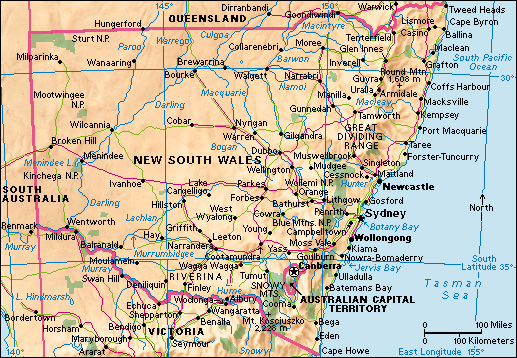Grafton (pop. 17,155) is a city in New South Wales, Australia. The Clarence River flows through Grafton. It forms a u shape that dips below the northern section of the city. The part of the city known as South Grafton lies south of the u. The city’s location near the river and the Pacific Highway has made Grafton a key commercial center in the region.


Major industries in Grafton include timber processing, beef- and dairy-cattle farming, and the processing of meat products. In addition, many Grafton residents work in the fishing, health care, and tourism industries.
The region’s climate—with warm, humid summers and mild winters—offers visitors excellent conditions to enjoy the local natural resources and other attractions. Grafton’s main events are the July Racing Carnival and the Jacaranda Festival, which occurs annually in late October or early November. The Jacaranda Festival, first held in 1935, celebrates the flowering of the blue-violet blossoms that grow on Grafton’s many jacaranda trees.
Elizabeth Island and Susan Island both lie in the Clarence River near Grafton. Northwestern Susan Island is covered by an area of rain forest that became a nature reserve in 1982. Susan Island is also known for its cultural and spiritual significance to the local Aboriginal people.
The Bundjalung and Gumbaynngirr Aboriginal peoples are the traditional inhabitants of the land that became Grafton. A number of European explorers, as well as many escaped convicts, encountered the Clarence River from 1799 through the early 1800’s. However, Europeans did not settle in the Grafton area until the 1830’s.
By the late 1840’s, there were two settled areas on the northern and southern banks of the river. Collectively, these areas were called “The Settlement.” The Settlement’s early industries included logging and shipbuilding. The land also attracted farmers, who raised livestock and grew such crops as corn and wheat. In 1849, the area north of the Clarence was surveyed and declared a town. It was named Grafton in honor of Sir Charles Fitzroy, the governor of New South Wales and a descendant of the Duke of Grafton. The part of The Settlement on the southern riverbank became known as South Grafton.
Grafton’s location on the Clarence River made the town an important center for commercial shipping. In 1859, Grafton was declared a municipality. It became a city in 1885. South Grafton became a municipality in 1897. The two communities were not physically connected until 1932, when a railway bridge was built over the Clarence. South Grafton officially merged with the city of Grafton in 1956.
Grafton has a long history of serious flooding. One of the worst floods on record occurred in January 2013. At the time, floodwaters from the Clarence overflowed sections of Grafton’s levees—that is, barriers built along rivers to keep them from flooding the land.
